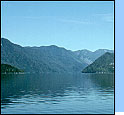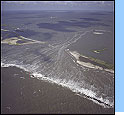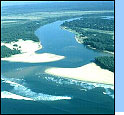 | |||||||
 |
Estuarine ScienceAll About EstuariesEstuaries are partially enclosed bodies of water along coastlines where fresh water and salt water meet and mix. They act as a transition zone between oceans and continents. An estuary has a free connection with the ocean. Fresh water input from land sources (usually rivers) dilutes the estuary's salt content. Most scientists accept the definition of D.W. Pritchard (1967): "An estuary is a semi-enclosed coastal body of water which has a free connection with the open sea and within which sea water is measurably diluted with fresh water derived from land drainage." Estuaries are known by many different names such as bays, sounds, inlets, harbors, and sloughs. Not all bodies of water with these names are estuaries. They must feature the mixing of fresh and salt water to be a true estuary. Estuaries are found throughout the world, with more than 100 along the United States coasts alone.
Why are estuaries important? Estuaries are vital habitats for thousands of marine species. Estuaries have been called the "nurseries of the sea" because the protected environment and abundant food provide an ideal location for fish and shellfish to reproduce. Most commercially important fish species spend some part of their life cycle in estuaries. Besides fish, many species of birds depend on estuaries for food and nesting areas. Migratory birds use estuaries as stopover points for resting and feeding before continuing their journey. Marine mammals also use estuaries as feeding grounds and nurseries. All these marine organisms feed in estuaries because a healthy estuary produces between 4 and 10 times as much organic matter as a cornfield of the same size. Estuaries provide a wide range of habitats leading to a great diversity of marine life. Estuaries are important for the health of the oceans. Estuaries can filter sediment and pollutants from the water before it flows into the oceans. Excess nutrients are removed in bordering salt marshes, resulting in cleaner water for people and marine organisms. Estuaries act as a buffer between the ocean and the land. They can decrease the effects of flooding and storm surges. The reduced impact on humans and buildings can save billions of dollars. Estuaries are economically important. Coastal activities, commercial and recreational fishing, boating, and tourism provide 28 million jobs and generate more than 20 billion dollars of income each year. Estuaries are a popular recreational destination. In 1993 more than 180 million Americans (about 70% of the population) visited ocean and bay beaches. Rhode Island has more than 85 marinas, 28 yacht clubs, 16 boat builders, 9 sailing schools, 100 public launching sites and swimming at more than 100 beaches. Estuaries have a historical and cultural significance. All over the world, people have always lived near estuaries, using them as food sources and transportation routes. Estuaries have become part of our history and our heritage. They will be a part of our future if we can find sustainable ways to use them and preserve their health. Some information in this section is from the EPA's Volunteer Estuary Monitoring Manual, from The National Estuarine Research Reserve System, and from the Rhode Island Economic Development Corporation.
|
||||||


